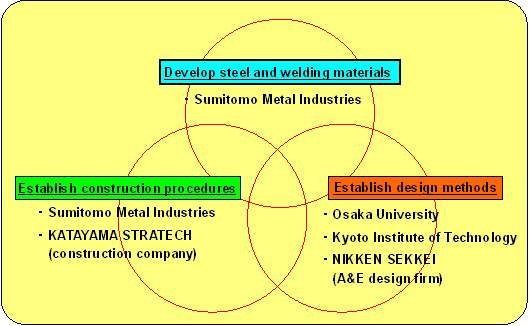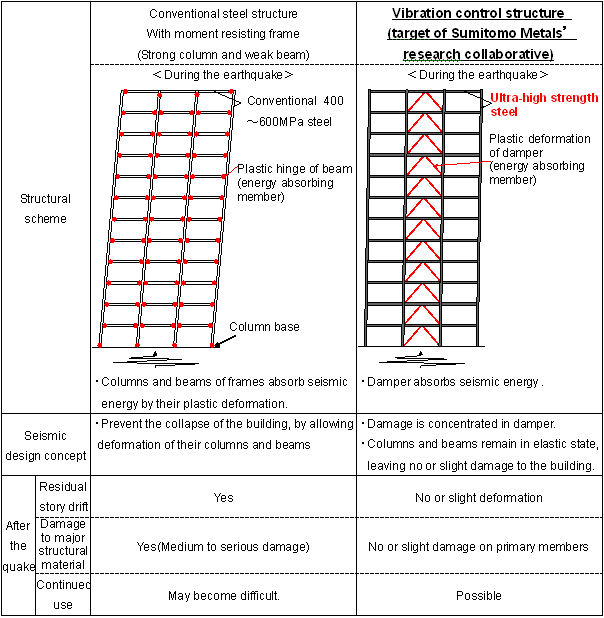Sumitomo Metals Develops Ultra High Strength Steel Platesto Prevent Damage to Buildings by Major Earthquakes
[Development of 1000MPa-Class Steel Plates (Trade Name: SSS1000) for Building Structures]
2008.10.16
- Sumitomo Metal Industries, Ltd.
A major advance has been achieved in development of structural materials for construction that are stronger and safer in the event of an earthquake. Sumitomo Metal Industries, Ltd. (Sumitomo Metals) has succeeded for the first time in the world to develop 1000MPa-class steel plates for structural material, jointly with Osaka University, Kyoto Institute of Technology, NIKKEN SEKKEI Ltd., and KATAYAMA STRATECH Corp. Specifically, the plates, having tensile strength in the 950MPa-class, have attained the maximum strength as steel plates used for major structural material for buildings. The use of the plates will enable the buildings to withstand major earthquakes with almost no damage. The new technology has been achieved by a research collaboration of private businesses and academy, and the Minister of Land, Infrastructure, and Transport has approved use of this newly developed steel product.
1. Background and objective of development
Most high-rise buildings and other large-scale structures with steel moment-resistant frames use steel plates as major construction material. In conventional seismic design, these frames are designed to undergo plastic deformation in case of earthquake to absorb the seismic energy applied to buildings in order to prevent the collapse of buildings and damage on human lives. However, continued use of buildings after severe earthquake motions often is impossible owing to plastic deformation(*1) of frames or story drift. This is a serious social and economic problem because earthquakes on the Japan Meteorological Agency Seismic Intensity 6 or more have been frequently registered in Japan, including the Great Hanshin Earthquake of 1995 and more recently the Iwate-Miyagi Nairiku Earthquake. Continued use of buildings with function retaining and with no or slight repair after severe earthquake should be realized. The development of the new 1000MPa-class steel plates increases the ability to provide seismic resistance to structures, and improves the probability that the structures will be usable after severe earthquake. Such steel plates enable primary structural elements such as columns and beams to remain in elastic state(*2) even after being subjected to a major earthquake.
This is why that the Sumitomo Metals and the other members of the research group devoted major efforts to developing the new high-strength steel plates.
2. Features of the new technology
As a way to acquire the ability for engineers to design buildings with high potential for withstanding major earthquakes without significant damage, the research collaborative proposed the use of 1000MPa-class high-strength steel plates (yield strength(*3) of 880MPa or more) with vibration damping devices. Such steel plates have double the yield strength of 590MPa-class high-strength steel plates (yield strength of 440MPa or more), the strongest steel plates generally currently used in construction. However, such high-strength steel plates did not exist and were not authorized in building structure use.
Being a top supplier of steel plates for penstocks (huge pipe made of steel plates) in hydropower station, Sumitomo Metals has the most advanced application technology and know-how in high-strength structural steel. Collaboration with an fabricating and engineering design firm and with a fabrication company were indispensable to apply high-strength steel to complex structures that have very different design parameters and fabricating conditions from penstocks.
Thus, in 2004, a collaborative research project was launched by Osaka University and Kyoto Institute of Technology (research overview and basic design), NIKKEN SEKKEI (practical design), KATAYAMA STRATECH (establishing fabrication conditions), and Sumitomo Metals (development of steel and welding materials).
One of the major challenges in applying 1000MPa-class steel in the construction field was to relax the strict management of welding procedure so as to have more general versatility. We have provided to other research team members the results of a series of evaluation tests under the most severe conditions and have succeeded in determining design and manufacturing conditions of optimal alloy elements of steel and welding materials.
The 1000MPa steel we developed was reviewed, and its use was authorized in accordance with the regulation of Article 37-2 of the Building Standard Law of Japan, by the Minister of Land, Infrastructure, and Transport on June 2, 2008.
For welding material, we have completed development, with Nippon Steel and Sumikin Welding Co., Ltd., a manufacturer of welding materials, of material that achieves a similar level of strength (yield strength) as the base material used to weld the 1000MPa-class steel, under a wide range of welding conditions. The welding material was approved by the Minister together with the 1000MPa-class steel.
3. Future developments
We will continue to develop design to achieve maximum performance of the method and promote further applications under the present cooperative scheme.
A Note on Technical Terms
(*1) Plastic deformation: A change in the shape of an object due to an applied force that is not reversible even after the force is removed. Permanent deformation begins when the elastic range ends.
(*2) Elastic state: The object returns to its original shape, once the forces which change the shape of an object is no longer applied.
(*3) Yield strength: The stress at which a material begins to deform plastically. Prior to the yield point the material will deform elastically and will return to its original shape when the applied stress is removed.

Chart 1: Collaborative Scheme

Chart 2: Proposed Structure
